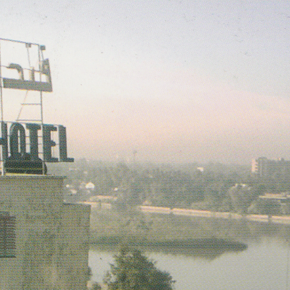“Mushroom soup, bitter greens with tomatoes the size of peas, rare roast beef sliced as thin as paper, noodles in a green sauce, cheese that melts on your tongue served with sweet blue grapes” — Hunger Games heroine Katniss Everdeen’s first meal in the Capitol is not distinguished by arcane preparation but the availability of high-quality ingredients.
Growing up in the remains of rural Appalachia, this self-reliant teenager has never had the luxury to choose what she wants to eat. When we meet her at the beginning of Suzanne Collins’ best-selling trilogy, the meat on her family’s table each night comes from the animals that she and her fellow outlaw Gale have brought home from the forbidden area beyond District 12’s security fence earlier in the day. And most of the other food they eat does as well, whether from berries and plants she has gathered there or the items she has traded any surplus meat for. In the post-apocalyptic North America of the Hunger Games series, having food that isn’t what contemporary foodies term “locally sourced” is the most reliable index of political privilege. The only people outside the Capitol who enjoy such a boon are those whom it singles out for reward, either because they do its bidding or because they are to be sacrificed in its honor.
Given the resentment Katniss already harbors towards the Capitol, it would make sense for her to reject her tastefully luxurious repast. That she does not do so, then, is significant. Despite the bleakness of her situation — she doesn’t expect to return home alive — she enjoys the food she is served, not only as a person who has known the fear of starvation, but one who sees it as more than mere sustenance. “The stew’s made with tender chunks of lamb and dried plums today,” Katniss reports a few days later, “perfect on the bed of wild rice.” She is clearly able to distinguish between the reasons why particular foods are suddenly available to her, all of them troubling, and the taste of the foods themselves.
Unfortunately, the recently released film of the eponymous first book in the Hunger Games trilogy sharply diminishes the role of food. As Natalie Wilson, who blogs at Professor, What If?, succinctly puts it, “If only the film had not lost the more weighty dealings with food, and given us a richer, more politicized meal.” While I disagree with Wilson that the film demonstrates a “heightened emphasis on romance” and think it does a pretty good job of communicating Collins’ political themes, I too had hoped it would do a better job of bringing the subject of hunger to the silver screen.
As much as I applaud the trilogy’s nods to The Grapes of Wrath and other tales of material deprivation — the film makes District 12 look like something straight out of Dorothea Lange‘s Depression Era photographs — its willingness to underscore the brutal realities of malnourishment, what impresses me most is that it doesn’t reduce hunger to the domain of necessity. We certainly see Katniss desperate for food and drink, mere hours from death by “natural causes.” But we also see her eagerly cleaning her plate when she is comparatively well fed. “How refreshing,” notes Wilson, “to see a female character that appreciates food.” Even under extremely trying circumstances, Katniss doesn’t just consume fuel like a machine, but makes note of what pleases her palate.
To be fair, the film adaptation of The Hunger Games does give us a clear sense that Katniss is someone who knows the fear of starvation and shows us through evocative mise-en-scène that she is confronted with a bounty that the residents of District 12 can otherwise only dream about. Because the screenplay dispenses with her first-person singular narration, though, moviegoers aren’t able to understand how much time she spends thinking about food in the books. As a consequence, they are deprived of the opportunity to recognize how deeply the trilogy immerses its readers in questions of political materialism.
The premise of The Hunger Games, for those who have yet to encounter the series is that most of the territory of the former United States has now become the nation of Panem, ruled from the Capitol, an isolated metropolis deep in the Rocky Mountains. Seventy-five years before the first book’s events, Panem’s thirteen outlying districts — a number that deliberately echoes the thirteen colonies that evolved into the United States of America — became disenchanted with this centralized authority and mounted a rebellion against it.
But the rebellion failed and the Capitol now exacts a brutal tribute from twelve of the thirteen districts; the last one, we learn, was destroyed to set an example. Each year two young people, one male and one female, between the ages of 12 and 18 are selected by lottery to participate in a nationally televised “battle royal” in which they must fight to the death until only one victor is standing. Rarely, someone will volunteer to take the place of the person selected, as Katniss does when her younger sister Prim’s name is called.
As compelling as the tale of this competition is — Collins crafts a page-turners that puts most “grown-up” mysteries to shame — it isn’t particularly original. Expertly combining legends of pagan sacrifice with accounts of everyday life in modern totalitarian societies, the Hunger Games trilogy reinvigorates the lesson of Shirley Jackson’s “The Lottery” and William Golding’s Lord of the Flies, as well as the Japanese novel Battle Royale it most obviously mirrors: civilization is much less removed from barbarism than we like to believe.
What makes Collins’ achievement stand out within that dystopian tradition is not the plot but her nuanced reflections on political power. Although we are always aware that Panem is an authoritarian society in which the threat of force is strong, fear isn’t sufficient to keep it from falling apart. The Capitol invests an enormous amount of time and energy in turning the Hunger Games into a spectacle shared by all. Even where viewership is coerced, audiences come to identify with tributes to such a degree that they are willing to donate money on their favorites’ behalf, providing them with resources that can mean the difference between life and death.
To be sure, the outlying districts have a rooting interest in their own tributes. But it is clear from Katniss’s memories of seeing the Games in previous years that she and her family found a way to stay engaged in the event long after District 12 had lost its representation. Much as fans of the World Cup adopt new allegiances once their own nation has been defeated, viewers throughout Panem are too deeply invested in the spectacle to resist the psychological mechanism of identification.
It’s hard to imagine a better illustration of Antonio Gramsci’s conception of hegemony. Trying to figure out how a manifestly unjust social order — such as the fascist Italy in which he was living under house arrest — could sustain itself without turning into a permanent military occupation, he theorized that cultural means must play a crucial role. How children are educated is extremely important. But the modern “bread and circuses” provided for entertainment of the masses also influence how they conceive of their place in the world. The Hunger Games constantly remind the population in Panem’s outlying districts of how little control they exert over the course of their lives, while simultaneously impressing upon them that the only way to survive such a predicament is to remember that everyone around them is ultimately an enemy.
In other words, the spectacle of the Hunger Games binds Panem together by weakening any pre-existing bonds that people have with one another. When audiences invest themselves in the spectacle, they are also investing in the State that produces it. That’s why the decision to volunteer as a tribute is so significant. Although television commentators do their best to spin it into another feel-good story with which to amp up interest in the contest, the selflessness of the act undermines the one-against-all mindset that the Capitol wishes to promote. As Collins’ story unfolds, Katniss’s refusal to put herself first becomes the foundation for more explicit forms of resistance.
The Hunger Games trilogy offers a timely allegory. In highlighting the tension between the many who struggle to get by and the few who are able to indulge themselves without restraint, it draws attention to the dynamic that led to last year’s Arab Spring, not to mention the message of the so-called “99%” in the Occupy movement. The story of resistance to a decadent centralized government holds obvious appeal for members of the Far Right in places like the United States, where anti-federalism has a long, complex history. But Collins’ focus on labor issues, as well her decision to displace the Capitol in these new, not-so-united States to a Rocky Mountain region known for its religious and political conservatism suggest that her own sympathies lie with the populist Left. Regardless of how you take the series’ call for revolution, though, its insistence that we pay close attention to food retains its force.
Given the books’ massive popularity with young adults, this emphasis is a reason to feel encouraged, for once, about what the future holds. At a time when technological advances are rendering a vast array of consumer goods expendable, dematerializing the brick-and-mortar economy at a demoralizing pace, the Hunger Games trilogy serves as a powerful reminder of what will continue to matter. And it invites readers to use that insight as the basis for a politics grounded in materialism. When new outbreaks in the districts interfere with the Capitol’s supply chain, the first impact comes in the form of food shortages. Residents of the metropolis who have never questioned the provenance of their culture, whether it comes in the form of produce or the televisual production of the Hunger Games, are suddenly forced to ponder the social order of Panem.
While the fate of tributes in the arena often turns on their ability to secure a supply of food, it isn’t just a resource to fight over videogame style. Wilson rightly emphasizes that “food is more than a weapon in the book — the procuring and sharing of it is an act not only of survival, but of love. The book’s heroic characters — Katniss, Gale, Peeta — all provide food for others while the villains — the Capitol, the Career tributes — hoard and waste food.” Even at the less rarified level of everyday life in District 12, though, the distribution of food is the primary reason for social interaction, the way in which a sense of community can be sustained in spite of the Capitol’s divide-and-conquer approach to governance.
Throughout the trilogy, Collins encourages readers to think hard about the relationship between taste and identity. As practically minded as Katniss is, she always remains attentive to what gives her pleasure, whether it’s something she touches, smells, hears or, most prominently, eats. Although she is keenly aware that the pleasures of the table she first encounters as a tribute in training come at a high price — the odds of making it back to District 12 are definitely not in her favor — she cannot help but enjoy them.
When Katniss is asked, during the public interviews that each tribute must perform prior to the commencement of the Hunger Games, what has impressed her most about the Capitol since her arrival, she can think of nothing to say but “the lamb stew.” This confession elicits laughter from the sophisticated Capitol audience and makes Katniss feel ashamed at her awkward way with words. But the honesty of this moment — she really does love the dish — need not be interpreted as a sign of what she lacks.
Sadly, the impulse to make fun of Katniss, as the audience does, is the product of a storied intellectual tradition. There is a strange moment in Immanuel Kant’s Critique of Judgement, so crucial in the formation of modern criticism, when Kant turns uncharacteristically to anecdote. He’s trying to explain why aesthetic evaluation needs to be disinterested: “If someone asks me whether I find the palace that I see before me beautiful, I may well say that I don’t like that sort of thing, which is made merely to be gaped at, or, like the Iroquois sachem, that nothing in Paris pleased him better than the cook-shops; in true Rousseau style, I might even vilify the vanity of the great who waste the sweat of the people on such superfluous things. . .” From Kant’s perspective, though, the absence of any personal investment in this palace, even outright disapproval of its existence on political grounds, has no bearing on whether it should be deemed beautiful or not. Through a strange sleight of hand, then, the Native American gentleman’s lack of interest in the spectacle of Louis XIV’s Paris becomes proof of his failure to achieve the proper degree of disinterest.
Comparing this reference to its source, Pierre François Xavier Charlevoix’s 1744 book History and General Description of New France helps put Kant’s passing reference to this Native American gentleman in perspective. Charlevoix fleshes out the scene considerably: “Iroquois who went to Paris in 1666 and who were shown all the royal houses and all the beauties of this great city admired nothing of this and would have preferred the villages to the capital of the leading monarchy of Europe if they had not seen the Rue de la Huchette, where they were immensely pleased with the grill-stalls that are there festooned with every kind of meat all the time.” Although Charlevoix obviously deems it noteworthy that the Iroquois — it’s significant, I think, that Kant turns Charlevoix’s plural delegation into a solitary individual — were so unimpressed with the spectacular attractions of Louis XIV’s metropolis, he doesn’t pass judgment on them in the way that Kant seems to be doing. The extra level of detail he provides also leaves open possibilities that Kant doesn’t consider. Could it be, for example, that the visitors’ interest in Parisian street food is a product, not of a hunger for food, but a hunger for knowledge?
While Kant would probably insist that this latter form of “hunger” still reflects interest, its mobilization of desire is at least liberated from the burden of material necessity. According to his way of thinking, the person who is motivated by physiological imperatives will find it impossible to be objective. But someone who isn’t worried about satisfying the demands of the body at least has potential to contemplate the world with detachment. Indeed, this is a point that the Hunger Games trilogy communicates very clearly. Only when Katniss has enough food and drink does her mind wander from the subject of self-preservation to more abstract ruminations on her condition and the political realities that shape it.
But she doesn’t experience this temporary liberation from deprivation as an invitation to indulge in lofty thoughts about the beautiful. Even when she is satisfied in a physiological sense, she remains politically hungry. As Katniss familiarizes herself with her new surroundings in the Capitol, she finds herself alternately captivated and disturbed by the technology at her disposal: “What must it be like, I wonder, to live in a world where food appears at the press of a button? How would I spend the hours I now commit to combing the woods for sustenance if it were so easy to come by? What do they do all day, these people in the Capitol, besides decorating their bodies and waiting around for a new shipment of tributes to roll in and die for their entertainment?”
This moment resonates powerfully with Charlevoix’s text. Like the Iroquois visitors to Paris he mentions, Katniss is a rustic provincial visiting a capital city full of impressive architecture and fashion. And also like them, she confronts the metropolis on her own terms, letting interest be her guide. It’s entirely plausible that the Iroquois were asking themselves the same kind of questions as Katniss. What does it mean for a society when the distribution of sustenance is centralized? How might the time freed up as a consequence be productively deployed? Does the easy availability of food, that partial liberation from the realm of necessity, lead ineluctably to a decadent lifestyle?
Maybe the Iroquois weren’t simply delighted at the prospect of having steak on a stick available any time of day or night. Maybe, instead, they were thinking about the ways in which European settlers and their preference for urban life would impact their own culture, creating opportunities as well as threats. Put another way, there’s a temporal dimension to interest as Kant defines it that bears heavily on our interpretation of the visitors’ actions.
Let me reframe this scenario in terms germane to my topic. What is it, ultimately, that drew the Iroquois visitors’ attention in what we might, in homage to Walter Benjamin, call the “Capital of the Seventeenth Century”? The selling of sustenance. And what kind of sustenance? The sort that was, by the standards of that age, the closest approximation to what we would call “fast food,” much like the street fare hawked the world over today, from Bangkok to Brussels, New York to New Dehli. In other words, the Iroquois, coming from a culture in which the production and consumption of food was a deliberate process with a strong ritual component, were intrigued by the extent to which human beings’ relation to eating— and their way of relating through eating — could be sped up by prying it loose from its agricultural origins.
Such a radical transformation of everyday life only becomes possible through the creation of empires, whether in the Egypt, Rome, or Paris of centuries past or the impossibly complex network of trans-national corporations and their facilitators in government to which Michael Hardt and Antonio Negri assigned the generic term “Empire.” What shows up in the markets and stalls of a city is a direct reflection of the power its rulers have to build and maintain distribution channels that work in its favor. Whether we’re contemplating the meat that made its way to the Rue de la Huchette in 1666 or the ingredients used in the lamb stew that Katniss Everdeen loves, we confront the same political realization. Surplus value congeals in food the same way it does in other commodities. If you let it linger on your tongue long enough, you can even taste it.
Photograph courtesy of the author






I just finished the trilogy, myself, and have not seen the film yet. I have quite a few thoughts, two literary observations (that the prose was elegant in it’s simplicity, that the story should have ended at the end of the first book) the rest political. Hunger, war, terrorism, human rights, reproductive rights, high capitalism and it’s excesses. During this time the only piece i read was the New Yorker’s one on race, which talks about this tumblr http://hungergamestweets.tumblr.com/ I thought that race was not really an issue central to the story, but I can see how it has become one, given it’s own political urgency, despite not being topicalised in the book.
I listened to the trilogy on audio book. While i listened, at a certain point, I found myself scrolling through endless #fashion posts on tumblr. This provided another narrative. I would like to leave you with this small selection of images.
http://elaine4queen.tumblr.com/day/2012/04/06
Thanks for reading, Elaine. And thanks for the Tumblr material.
The race issue is, of course, a huge deal in the United States, especially given all the animus against our non-white President. It provides insight into the nature of literary identification, which is a good thing, even if triggered by something deeply disturbing.
I know a lot of people who feel the first book should have been allowed to stand alone. Personally, though, I think the messiness of the second and third books, the way they show how hard it is to have anything good come from striving for power, is really important, if also frustrating, for the political points Collins surely wanted to make. There’s a lot of interesting stuff about food in the second and third books, too, but I didn’t want to overdo the spoilers.
The thing I found most annoying about the books was the first person point of view as well as the fact that they were in present tense— it felt appropriately adolescent to me, but also made Katniss more unreliable as a narrator than I wanted her to be. But, like Charlie, during the film I found myself missing Katniss’ inner dialogue, not just with the food, but also the absence of the depth of her conflict over her feelings for Gale. I kept wondering what, if anything, could have made up for that?
Also: Many of my students, who are 12-13, were very disappointed by the movie. Their critique is that the filmmakers “changed everything,” which I’m now thinking could be their 7th-grade way of saying that there was a depth missing, perhaps from the absence of the first-person voice.
That’s really interesting, Annie, that they felt the movie changed a lot. Because it really didn’t, aside from the first-person voice, which is hard to capture in a non-gimmicky way in cinema. My daughter loved the film. But we had also had conversations in the days leading up to the premiere about how they would change things to make the story work on screen. She has read the Harry Potter books and seen the movies so many times that she has learned to think long and hard about the problems of adaptation. Plus, we had also been talking about the concept of the unreliable narrator and to which extent Katniss should be considered one!
I appreciated the fact that Katniss Everdeen is stronger than any men in the book/film–she is to this generation of tweens what Sigourney Weaver was to ours in “Alien.” That being said, I would have appreciated her much more had the teen romance element been played down or missing entirely. We’ve seen many women heros in the Arab Spring uprisings. I would prefer not to know about their love interests.
I’ve heard other folks make that argument, one that has obvious merits. But the romance angle isn’t THAT played up. Most of the interactions Katniss has with Peeta are first and foremost determined by the impulse to survive. And I think it’s also true that more teenagers were — and are — likely to read the books because there is a romance angle. If that gets them hooked and leads them to ponder the books’ political themes, I am OK with that.